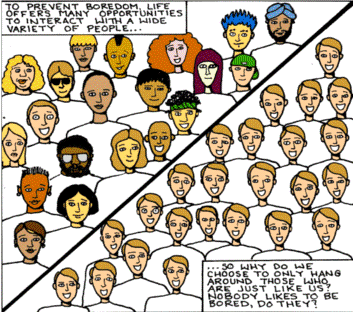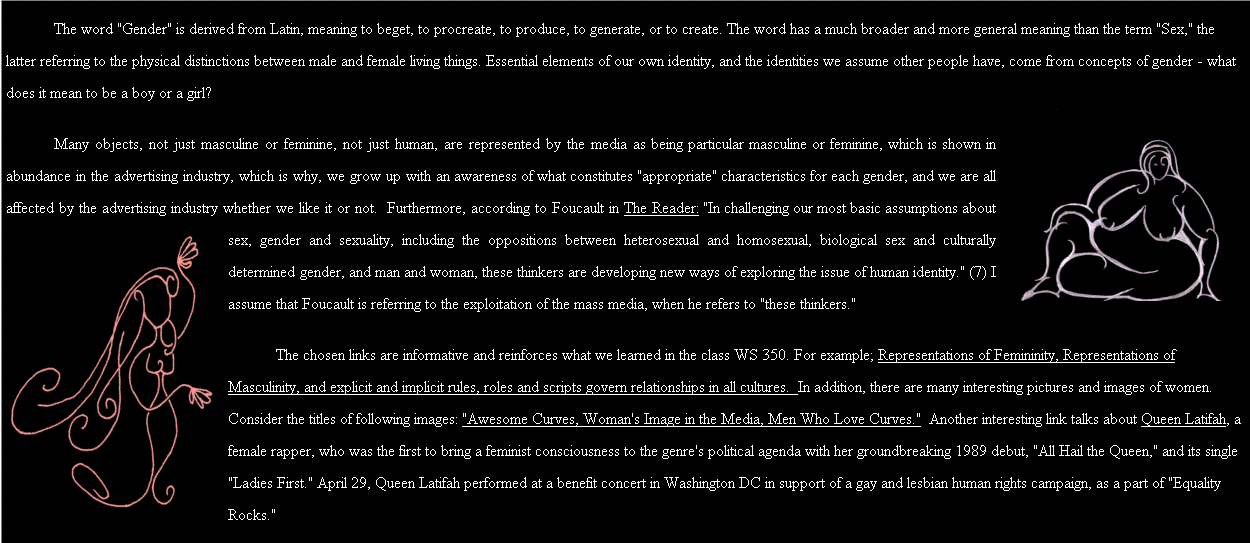

Media's Media's Influence On Society
“The media’s the most powerful entity on earth. They have the power to make the innocent guilty and to make the guilty innocent, and that’s power. Because they control the minds of the masses.” - Malcolm X
Race
Cultural racism

With the shows above, it appears how the Asian women and the Latino woman are depicted in roles that “under-represent” their being, culture, heritage, and individualism. “It is equally slim to find minorities with lead roles in shows with predominantly white casts on these networks” (racerelations.about.com) Such recurring roles given to minorities will depict society and viewers that the cultures the minorities represent are low and from a working class, underprivileged and un-American.
Society of America consists of diverse cultures with whom media should consider in the entertainment, television, radios, prints, etc. Since there lives a diverse culture in this nation, the shows and radio stations should respectively correspond to the people and not only the Whites. Or, sometimes the media includes minority groups in their television shows, movies and so on, however, these roles are that of a less representation of what these minority groups really represent. For example, the role of the Latino maid in the show Will & Grace represents society that Latinos are not any better than that of a maid. Thus, society and viewers assume and prejudge that all Latinos stand at a ground level that of a maid. Due to differences in racial factors such as skin color, language, and culture, society divides and assorts Americans regardless of who they are individually. Therefore, because of white power and white privilege, many scenes in the media are represented and played by t
Fortunately, the networks began to respond as more communities of diverse races began speaking out the aggravation caused by the destructive and stereotypical images seen in the media. Due to the “Brown Out” ac
Class

Gender

Sexuality
More than before, the media has taken the role as the leading agent for communication. Most themes produced by mass media are based on sexism. They tie down the potential of both women and men to a finite limit. Based on Marriam Webster the definition for sexism is “the prejudice or discrimination based on sex; especially discrimination against women. Behavior, conditions, or attitudes that foster stereotypes of social roles based on sex.”
“Media Awareness Network”, that is a media and internet education resource both for the teachers and parents indicates that: “For several decades now, media critics and feminists alike have been examining the role of the media in creating and reinforcing stereotypical representations of women and femininity. But only recently have they expanded the research to consider how the media also construct, inform and reinforce prevalent ideas about men and masculinity.”
Jacobson and Mazur in their “Sexism and sexuality in advertising” state “Beer companies have been notorious for exploiting women in their everyday promotions. Watching a football game, you can usually find an attractive young lady being swept off her feet by a less than attractive man after he opens the beer of his choice.”

The Girls, Women + Media Project is a 21st century, non-profit initiative and network working to increase awareness of how pop culture and media represent, affect, employ, and serve girls and women---and to advocate for improvement in those areas. In part of their website their focus is on the unrealistic way that media portrays most of the women.

Many girls go through magazines and diet menus to stay skinny and thin in order to be accepted by their peers. The Daily Eastern News is the 9,100-circulation paper for Eastern Illinois University in Charleston, Ill. In an article submitted by Youngchi Chang/ Staff Writer on March 2005 in this online news letter, she quoted; “Women are not represented well or realistically in the media, said Terry Johnson, assistant professor of journalism. The ‘ideal’ woman in advertising, especially in magazines, is a concept that has hurt many women who strive consciously or unconsciously to be thin, and it has generated numerous unhealthy lifestyles.”

Mab Segrest on her “On Being White and Other Lies” talks about the era of African enslavement in Virginia. “British colonies used the ‘rule of hypo-decent’, which categorized anyone with any African parentage as belonging to the subordinate race. This practice allowed plantation masters to have sexual access to Black women without jeopardizing the inheritance of white children” (p.251).
The message that the media passes on is a combination of racisms and sexism stereotypes. Black women experience double oppression as being women and black. Audre Lorde states in her “Age, race, Class, And Sex.” “…sexual hostility against Black women is practiced not only by the white racist society, but implemented within our Black communities as well.”(p. 181).
Ndidi Moses, a media studies major at Penn State, touches the cover of Cosmopolitan. The woman under the title is thin and white, with strawberry-blonde hair and azure eyes. She wears a come-hither look and a white lace dress that leaves her torso almost bare. "That dress is beautiful," Moses says, running her fingers across the page. "You couldn't wear it out, but for a fashion show . . . I wonder if that's her real body." She opens the issue of Cosmo and finds the first ad portraying a black woman — almost 20 pages in. The woman is modeling flowery underwear; her hip bones jut out above the waistband. Moses points at the picture. "African American women looking at these images might say, out loud, 'She's too skinny. She shouldn't be this thin.' And they really think she's too thin. They know that most black women don't look like that, but in my study they were looking at a booklet full of thin black women, so they began to question their knowledge base. Maybe deep down they started wondering, 'Should I look like that?'"
Sources
http://www.media-awareness.ca/english/issues/stereotyping/women_and_girls/women_sex.cfm
http://www.soc.ucsb.edu/sexinfo/?article=activity&refid=026
http://www.mediaed.org/news/articles/svp
http://www.museum.tv/archives/etv/S/htmlS/socialclass/socialclass.htm
http://www.mediaknowall.com/gender.html
http://www.ruthieogrant.org/CulturalRacism.htm
http://racerelations.about.com/library/wekkly/aa080199.htm
WS 350 Online - Summer 2005. Dr. Sheena Malhotra. Course Reader: Intersections of Gender, Race, Class & Sexuality.
Alexander, Jacqui. Sing, Whisper, Shout, Pray!: Feminist Visions for a Just World. Fort Bragg, CA : EdgeWork Books, 2003.